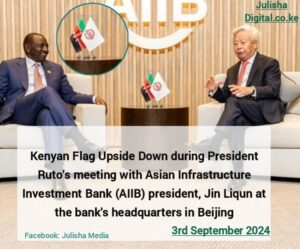Kenyans Criticize President Ruto’s Team Over Upside-Down Flag Incident
VICTOR KIPCHUMBA September 4, 2024 0
PHOTO: President William Ruto and the upside-down Kenyan flag during a meeting with AIIB President and Board of Directors Chairman Jin Liqun in Beijing, China.
President William Ruto’s recent trip to China has sparked widespread criticism. His protocol team carelessly displayed the Kenyan flag upside down during high-level meetings. This mishap has raised concerns among Kenyans about the competence of the team managing these important state affairs.
A Repeated Mistake
On the second day of his trip to China, President Ruto met with the Asian Infrastructure Investment Bank (AIIB) President Jin Liqun and other bank officials. However, instead of the focus being on crucial conversations about Kenya’s economic relations, attention turned to an embarrassing blunder: the Kenyan flag on display was upside down.
The Kenyan flag should always be flown with the black stripe at the top and the green stripe at the bottom. But during this meeting, the green stripe appeared on top. This mistake is not just a minor oversight; it signifies a disregard for proper protocol. It also stands as the second time this mistake has occurred during President Ruto’s international trips.
Public Backlash
As the photos of the upside-down flag spread online, Kenyans expressed their outrage. Veteran journalist Ali Manzu was among the first to point out the mistake. He tweeted, “Mr. President @WilliamsRuto, our flag is upside down. Kindly next time check, it’s the second time this is happening…” His tweet quickly gained traction, with Kenyans joining in to criticize the carelessness of the president’s handlers.
Many online users were quick to remind Manzu that this was actually the third time the flag had been displayed upside down. A social media user commented, “No, it’s three times now. And despite constant corrections, they never seem to care.”
Protocol Issues During Key Events
Journalist Mwangi Maina also weighed in on the discussion, questioning the role of the protocol team during such high-level meetings. “The Kenyan flag is a powerful symbol of patriotism and national pride. It should never be displayed upside down under any circumstances. However, there have been notable lapses in flag protocol during important international events,” Maina remarked.
He recalled previous incidents where the same mistake had been made. “This occurred in Djibouti during the IGAD summit with President Ruto present. It happened again in Kampala on the sidelines of the NAM summit with Mudavadi in attendance. And now, it has occurred yet again in China during a presidential meeting.”
Maina’s sentiments echoed those of many Kenyans, who questioned the competency of the protocol team responsible for ensuring such mistakes don’t happen. He added, “What exactly is the protocol team doing during these trips? Are we sending a message of distress?”
Symbolic Interpretations
While many were understandably upset about the flag being flown incorrectly, some took a more symbolic interpretation of the mistake. One Kenyan, Grace Kitheka, suggested that perhaps the upside-down flag reflected the state of the nation under Ruto’s leadership. “Maybe this is indicative of the kind of country Ruto is running right now… A country which has its priorities upside down. Schools, hospitals, universities are all grounded. But a Chinese loan is what we need most!” Kitheka’s comment reflected the broader discontent felt by many citizens who believe the government is neglecting its people’s most urgent needs.
Maina further emphasized the importance of being vigilant during international meetings, adding, “As a visiting delegation, it’s essential to keep your antennas up and be vigilant about every detail. If the host doesn’t catch an issue, it’s your responsibility to notice and demand protocol be followed correctly.”
Previous Incidents of the Same Error
This is not the first time the Kenyan flag has been displayed incorrectly at international events. At the IGAD meeting in Djibouti, the full-length Kenyan flag was flown upside down while President Ruto engaged in discussions with other leaders. Just a few months later, at a summit in Uganda, Prime Cabinet Secretary Musalia Mudavadi also had to endure the embarrassment of standing before an upside-down flag during a meeting with his Tanzanian counterpart.
This pattern of protocol blunders even extends to domestic events. During the Jamhuri Day celebrations in December 2022, Governor Kawira Mwangaza’s administration draped the Kenyan flag upside down around the podium. Despite being called out on numerous occasions for these embarrassing mistakes, no official explanation or apology has been issued by the leaders involved.
Experts Weigh In
Public relations expert Bernard Aloo also expressed his concerns over the repeated protocol breaches. “Kenya’s protocol team is really making a mockery of the Kenyan flag. Third time having the flag upside down at an international event is no longer just a small slip-up; it’s a major breach. Next time a host confuses our flag with South Sudan’s, I’m pretty sure it’ll go unnoticed!”
Aloo’s comments reflect a growing frustration among Kenyans about the lack of professionalism demonstrated by the teams responsible for representing the country on the global stage. While some may dismiss the upside-down flag as a minor error, others see it as symptomatic of a much larger issue: a government that fails to pay attention to detail and prioritizes optics over substance.
Flag protocol breaches are not unique to Kenya. In May, U.S. Supreme Court Justice Samuel Alito faced criticism for flying the American flag upside down outside his home. This act drew intense backlash, particularly because an upside-down flag can signal a nation in distress.
In January 2021, violent insurrectionists carried the American flag upside down into the U.S. Capitol during the January 6 riot. This act was seen as a symbol of protest against the peaceful transfer of power following Donald Trump’s defeat in the presidential election.
Although the U.S. flag code permits flying the flag upside down only as a signal of extreme distress, it has increasingly been used as a form of political protest. However, in Kenya’s case, the upside-down flag does not appear to carry any deliberate symbolic meaning. Instead, it represents a troubling lack of attention to detail and a disregard for protocol.
Conclusion
The careless display of the Kenyan flag upside down has become a repeated embarrassment for the country on the international stage. As Kenyans continue to voice their frustrations, the government must take steps to ensure such protocol breaches do not happen again. While a small mistake on the surface, the upside-down flag reflects deeper concerns about the administration’s competence and the message it sends to the world.
The protocol team must pay closer attention to every detail during high-level meetings to ensure Kenya’s national symbols are displayed with the respect they deserve. As Kenyans wait for answers and possibly an apology from the government, many hope that the country’s leadership will take greater care in representing the nation both locally and internationally.


